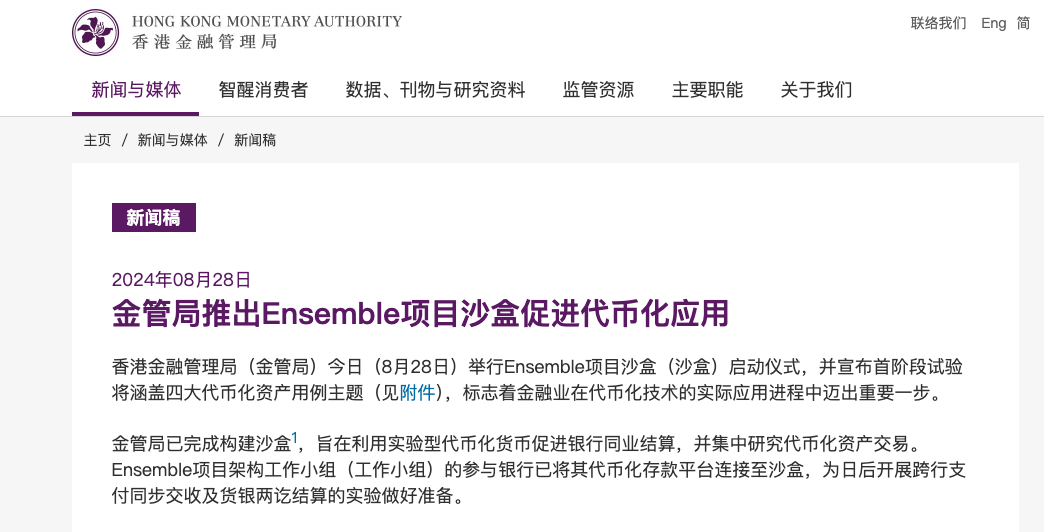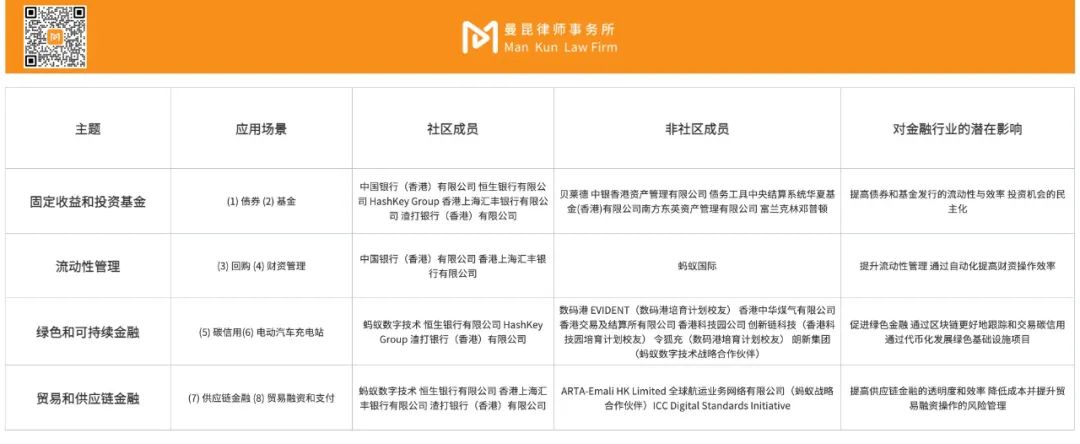Strict supervision and active exploration
Author: Bai Qin, Liu Honglin, Lawyer , Mankiw Blockchain Legal Services
On September 5, 2024, the highly anticipated "Inclusion·The Bund Conference" officially kicked off at the Shanghai Huangpu Expo Park. For Web3 practitioners, the most important theme forum of this world-class technology event was the afternoon forum "Talking about the future: the 'realization' of Web3 digital dreams".
The forum was jointly hosted by Ant Digital Technology and Foresight News . During the forum, many industry leaders gave keynote speeches and held roundtable discussions. Among them, we heard some familiar voices, such as:

- Xu Changjun, Chairman of Langxin Group, delivered a keynote speech titled "Exploring New Investment Paths and Unleashing the Power of New Energy";
- ZAN CEO Zhang Chenguang delivered a keynote speech entitled "Exploration and Practice of DT RWA Empowering New Energy Industry in the VUCA Era";
- Xiao Gang, member of the 13th National Committee of the Chinese People's Political Consultative Conference and former chairman of the China Securities Regulatory Commission, delivered a speech entitled "New Driving Force of Financial Technology, New Engine of Digital Economy".
It is not difficult to find that RWA has become the "main theme" discussed by Web3 practitioners in this theme forum. As Xiao Gang said: In the changes brought about by Web3, RWA is a bridge connecting the digital economy and the real economy, establishing a value mapping with the physical assets and IP products in the real world, and improving the liquidity and tradability of real assets.
In fact, as early as the end of August, a piece of news in Hong Kong, China ignited the topic of RWA. On August 28, 2024, the Hong Kong Monetary Authority (HKMA) took another step to promote innovation in crypto finance and launched a sandbox program called "Ensemble". According to the HKMA's press release, the Ensemble project sandbox aims to promote interbank settlement using experimental tokenized currencies and focus on tokenized asset transactions.

At the same time, the HKMA announced that the first phase of the trial will cover four major tokenized asset use case themes, including: fixed income and investment funds, liquidity management, green and sustainable finance, and trade and supply chain financing.
As soon as the news came out, Web3 practitioners started to discuss and pay attention to the Hong Kong RWA track. In this article, Lawyer Mankiw shared his analysis of the sandbox itself and its impact on the industry.
The vision behind Ensemble
It is no exaggeration to say that this initiative marks a major milestone in the development of Hong Kong’s digital asset ecosystem, revolutionizing the conduct and regulation of financial transactions. The Ensemble Sandbox, conceived by the HKMA, is not only a regulatory tool, but also a dynamic testing platform where innovative ideas are transformed into practical solutions. Ensemble’s vision is closely linked to the technical testing phase, and each test is a cornerstone to achieve this broader goal.

In recent years, the HKMA has been very active in exploring the potential of digital currencies and new technologies, especially in the area of central bank digital currencies (CBDCs), with efforts like the mBridge project and e-HKD being particularly notable. However, the HKMA also recognizes that the future financial world will not only be shaped by CBDCs. Tokenization, which uses blockchain technology to digitize assets, is another key piece of the puzzle. By tokenizing commercial bank money and real-world assets, financial transactions can be more streamlined, creating new opportunities for innovation. Therefore, the integration of CBDC and asset tokenization into the Ensemble Sandbox reflects the HKMA’s clear strategy to explore the synergies between these innovations, ensuring that these technologies complement each other in creating a more robust and versatile digital financial ecosystem.
The main objectives of Ensemble can be summarized as follows, each of which aims to advance the understanding and application of tokenization in finance.
- Explore application scenarios: Allow participants to experiment with tokenized assets in a safe environment and explore various applications without having to face the pressure of full implementation immediately.
- Technical testing: Testing the compatibility between different digital assets, tokenized deposits, and CBDC. This phase is critical to ensuring the technology is robust and ready for wider adoption.
- Developing Industry Standards: Developing common industry benchmarks for tokenization is critical as the technology evolves. By facilitating the entire lifecycle of a tokenized asset transaction, from creation to trading to payment and settlement, the sandbox helps participants understand the practical impact of tokenization and its potential to solve real-world challenges, such as its application in supply chain finance.
- Solving real-world challenges: The Sandbox promotes innovative applications that aim to solve real problems in the financing space, particularly in areas such as trade and supply chain finance. By addressing these pain points, Ensemble is helping to make tokenization a viable option for businesses.
Four major themes of asset tokenization
The HKMA’s Ensemble Sandbox project has identified four key themes for initial experiments, each representing an important part of the financial sector. These main themes have been carefully selected because they represent key areas where asset tokenization could have the most profound impact.
- Fixed Income and Investment Funds: This track explores how tokenization can transform traditional investment vehicles, making them more accessible and efficient. By creating a digital representation of a bond or investment fund, the financial industry can reduce settlement times, lower costs, and enhance liquidity, providing new opportunities for investors.
- Liquidity Management: Tokenization has the potential to revolutionize liquidity management by allowing assets to be fractionalized and traded on digital platforms. This could lead to more dynamic and efficient liquidity management, especially in situations where quick access to funds is critical.
- Green and Sustainable Finance: The HKMA is also looking at how tokenization can support green and sustainable finance initiatives. By tokenizing assets such as green bonds or carbon credits, the financial sector can enhance transparency and traceability, ensuring that funds are effectively allocated to environmental projects.
- Trade and supply chain finance: Tokenization can solve significant pain points in trade and supply chain finance by simplifying the process of tracking and transferring ownership of goods and financial assets. This can improve supply chain efficiency and transparency, reduce the risk of fraud, and enhance overall market confidence.

Tokenized real-world assets
Imagine you own a piece of real estate worth $1 million. Through tokenization, you can convert that property into 1 million digital tokens, each of which represents a fraction of the ownership of the property. These tokens can be traded, sold, and even used as collateral for other financial transactions within the blockchain ecosystem. Think of it as a digital representation of a real asset that can be easily traded, transferred, or used for various financial transactions within a secure decentralized network.

Tokenization of real-world assets is one of the key areas of experimentation for the Ensemble Sandbox. By experimenting with real-world assets, the sandbox can test the practicality and benefits of bringing traditional assets into the digital realm. This is not only in line with the HKMA’s vision, but also lays the foundation for future developments in the wider financial landscape, such as:
- Enhanced liquidity. Traditional real-world assets like real estate tend to be illiquid, meaning they can be difficult to sell quickly. Tokenization allows these assets to be fragmented into smaller tokens that are more easily traded, improving liquidity.
- Increased accessibility. Tokenization makes asset classes that were previously out of reach for many investors more broadly accessible. For example, someone with limited capital can purchase a fraction of a high-value asset, such as real estate, through a token.
- Lower transaction costs. Blockchain technology can reduce the costs of trading and transferring assets because it eliminates the need for intermediaries such as brokers or escrow agents.
Global cooperation and future prospects
Perhaps one of the most exciting aspects of Ensemble is its potential to facilitate cross-border payments. Currently, the Hong Kong Monetary Authority has demonstrated this capability through a successful collaboration with the Bank of France, where the two sandbox systems were connected to perform atomic cross-border settlements. This is just one example of how Ensemble is laying the foundation for a more interconnected global financial system.
In short, the Ensemble Sandbox is a microcosm of the future digital financial landscape. By combining cutting-edge technology, strategic collaboration and practical applications, it not only advances the HKMA’s vision, but also sets a global standard for digital asset innovation.
Disclaimer: As a blockchain information platform, the articles published on this site only represent the personal opinions of the author and guests, and have nothing to do with the position of Web3Caff. The information in the article is for reference only and does not constitute any investment advice or offer. Please comply with the relevant laws and regulations of your country or region.
Welcome to join the Web3Caff official community : X (Twitter) account | WeChat reader group | WeChat public account | Telegram subscription group | Telegram exchange group









